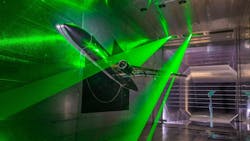DLR improves the prediction of flight characteristics for future aircraft
GOTTINGEN, Germany - In wind-tunnel tests, the German Aerospace Center (Deutsches Zentrum für Luft- und Raumfahrt; DLR) has investigated the lift generated by commercial aircraft using state-of-the-art measurement and simulation technologies. The findings will help to predict the characteristics of future aircraft much more accurately than before, in order to make them quieter, more efficient and more environmentally friendly, DLR reports. Continue reading original article.
The Military & Aerospace Electronics take:
18 October 2023 -The German Aerospace Center notes that the development of a new aircraft is a lengthy and complex process. An interaction between computer simulations and wind tunnel experiments takes place long before construction and the first flight. "Highly accurate simulations of the airflow around an aircraft are necessary to accurately and reliably predict the aerodynamics and thus the flight envelope of current and future aircraft configurations," says Project Coordinator Cornelia Grabe of the DLR Institute of Aerodynamics and Flow Technology in Göttingen. The same applies to identifying the safe operating range of the engines. The DLR 'Adaptive Data-driven Physical Modelling towards Border of Envelope Applications' (ADaMant) project aims to develop and demonstrate computer models for such high-precision flow simulations.
Related: Purdue hypersonics receives boost from Northrop Grumman shock tunnel donation
Related: Lilium Jet enters powered test phase
Jamie Whitney, Senior Editor
Military + Aerospace Electronics
